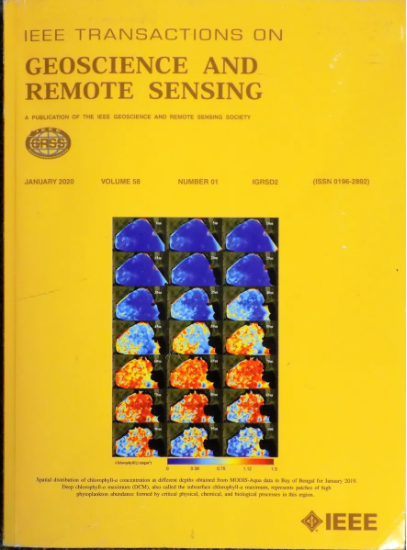An Autoencoder Architecture for L-Band Passive Microwave Retrieval of Landscape Freeze-Thaw Cycle
IF 8.6
1区 地球科学
Q1 ENGINEERING, ELECTRICAL & ELECTRONIC
IEEE Transactions on Geoscience and Remote Sensing
Pub Date : 2025-01-15
DOI:10.1109/TGRS.2025.3530356
引用次数: 0
Abstract
Estimating the landscape and soil freeze-thaw (FT) dynamics in the Northern Hemisphere (NH) is crucial for understanding permafrost response to global warming and changes in regional and global carbon budgets. A new framework for surface FT-cycle retrievals using L-band microwave radiometry based on a deep convolutional autoencoder neural network is presented. This framework defines the landscape FT-cycle retrieval as a time-series anomaly detection problem, considering the frozen states as normal and the thawed states as anomalies. The autoencoder retrieves the FT-cycle probabilistically through supervised reconstruction of the brightness temperature (TB) time series using a contrastive loss function that minimizes (maximizes) the reconstruction error for the peak winter (summer). Using the data provided by the Soil Moisture Active Passive (SMAP) satellite, it is demonstrated that the framework learns to isolate the landscape FT states over different land surface types with varying complexities related to the radiometric characteristics of snow cover, lake-ice phenology, and vegetation canopy. The consistency of the retrievals is assessed over Alaska using in situ observations, demonstrating an 11% improvement in accuracy and reduced uncertainties compared to traditional methods that rely on thresholding the normalized polarization ratio (NPR).景观冻融循环l波段被动微波反演的自编码器结构
估算北半球(NH)的景观和土壤冻融(FT)动态对于了解永久冻土对全球变暖和区域和全球碳收支变化的响应至关重要。提出了一种基于深度卷积自编码器神经网络的l波段微波辐射测量表面ft周期检索的新框架。该框架将景观ft周期检索定义为时间序列异常检测问题,将冻结状态视为正常状态,将解冻状态视为异常状态。自动编码器通过使用对比损失函数对亮度温度(TB)时间序列进行监督重建,以概率方式检索ft周期,该对比损失函数使峰值冬季(夏季)的重建误差最小化(最大化)。利用土壤水分主动被动(SMAP)卫星提供的数据,该框架可以学习分离不同地表类型的景观FT状态,这些地表类型具有与积雪、湖冰物候和植被冠层的辐射特征相关的不同复杂性。在阿拉斯加使用现场观测评估了检索结果的一致性,与依赖于归一化极化比(NPR)阈值的传统方法相比,检索结果的准确性提高了11%,不确定性降低了。
本文章由计算机程序翻译,如有差异,请以英文原文为准。
求助全文
约1分钟内获得全文
求助全文
来源期刊

IEEE Transactions on Geoscience and Remote Sensing
工程技术-地球化学与地球物理
CiteScore
11.50
自引率
28.00%
发文量
1912
审稿时长
4.0 months
期刊介绍:
IEEE Transactions on Geoscience and Remote Sensing (TGRS) is a monthly publication that focuses on the theory, concepts, and techniques of science and engineering as applied to sensing the land, oceans, atmosphere, and space; and the processing, interpretation, and dissemination of this information.
 求助内容:
求助内容: 应助结果提醒方式:
应助结果提醒方式:


